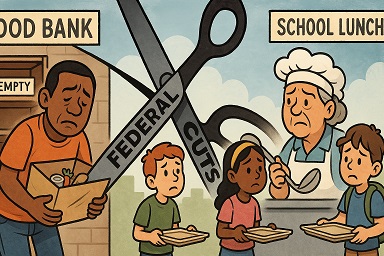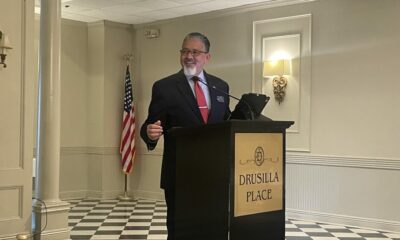News from the South - Arkansas News Feed
Federal cuts squeeze already-struggling food banks, school lunch programs

by Kevin Hardy, Stateline, Arkansas Advocate
March 27, 2025
For the Day Eagle Hope Project, federal money has helped volunteers deliver fresh produce and meat to families in need across the remote Fort Belknap Indian Reservation in northern Montana — while putting cash into the hands of farmers, ranchers and meat processors.
The nonprofit generally has less than $300,000 to spend per year. So the $200,000 from a U.S. Department of Agriculture local food buying program significantly raised both the quantity and quality of the food it could distribute.
“They were a major, major contributor to our food,” said Tescha Hawley, who directs the organization, which aims to improve physical, mental and spiritual health.
The USDA recently nixed more than $1 billion from two programs that helped food banks and school meal programs buy local foods, including $660 million for schoolchildren. U.S. Agriculture Secretary Brooke Rollins recently described the programs as “nonessential.”
But the move has left hundreds of school systems and food banks reeling. They already face rising food prices and are struggling to help community members with growing food insecurity.
Created in response to the COVID-19 pandemic, the Local Food Purchase Assistance and the Local Food for Schools programs aimed to build more resilient supply chains of domestic food by connecting schools and food pantries with small ranches, farms and dairies. The program was initially funded by 2021’s American Rescue Plan Act but later expanded by the Biden administration.
The federal programs stimulated the purchase of locally grown fruits, vegetables, dairy and meats — benefiting both the smaller farmers who received fair market pay for their products and the organizations granted funds to buy high quality foods.
The noncompetitive grants sent hundreds of millions of dollars to all 50 states, the District of Columbia and 84 tribal governments, boosting business for more than 8,000 farmers and providing local food to almost as many food banks. The Trump administration is killing the programs, despite Health and Human Services Secretary Robert F. Kennedy Jr.’s campaign against processed food, which he says is “poisoning” Americans.
Without ongoing funding, Hawley said, she would have to rely on cheaper, less nutritious food.
“It’s simple, right? I can get a truck … in here with all highly processed food, no problem,” she said.
Schools are facing a similar challenge: While officials running breakfast and lunch programs would prefer to buy more local products, those are often expensive. And with underfunding, high food costs and labor struggles, school lunch programs are already stretched thin.
In Milan, Tennessee, the federal funds allowed the local school system to buy minimally processed beef from a local stockyard, and broccoli, purple hull peas, tomatoes and melons from local growers.
Vickie Dunaway, who supervises the school system’s food services, told the Tennessee Lookout the federal cuts mean “going backwards” on purchasing healthier foods.
“That will obviously have to be cut out, because our budget will not withstand being able to purchase local,” she said. “Purchasing local, minimally processed food is way more expensive than buying from a distributor.”
A ‘devastating’ cut to food banks
Late last year, USDA said the programs had already spent more than $1 billion on local foods, and announced an expansion of the two programs with an additional $1.13 billion. USDA has killed that $1.13 billion expansion; it is still reimbursing the previously committed funds.
The Trump administration, which has sought to dramatically slash the size of the federal government, told recipients earlier this month that the programs “no longer effectuate the goals of the agency.”
In a statement to Stateline, the USDA said the current administration is “prioritizing stable, proven solutions that deliver lasting impact.”
“The COVID era is over — USDA’s approach to nutrition programs will reflect that reality moving forward,” the statement said.
The only thing we’ll be able to do is just ration what little we have — to spread it as thinly as possible over the number of households we provide food to.
– Eric Cooper, president and CEO, San Antonio Food Bank
The nonpartisan National Association of State Departments of Agriculture, which represents the ag department leaders of all 50 states, last month lobbied the federal government to continue the local foods program with permanent funding and ease procurement regulations for school meal programs. Arkansas Secretary of Agriculture Wes Ward, president of the association, said in a statement that the local food programs aid both producers and consumers.
“Investing in local and regional food systems not only strengthens the connections between farmers and their local communities, it bolsters supply chain resiliency as well,” his statement read.
In New Mexico, the program allowed food banks to buy some 900,000 pounds of locally grown food from more than 200 farmers since 2023. Before the program was terminated, the state was expecting close to $3 million in additional funding, Source New Mexico reported.
Jill Dixon, executive director of The Food Depot in northern New Mexico, called the cuts “devastating.”
In Texas, the San Antonio Food Bank counted on USDA’s local food program to help round out the food boxes it provides to families in need. The food bank, which serves more than 100,000 people across 29 Texas counties, largely relies on donated foods from hotels, restaurants and grocery stores.
“The challenge is I might get peanut butter donated, but I don’t have the jelly, or I might have pasta donated, but I don’t have the marinara,” said Eric Cooper, president and CEO of the food bank. “This program allowed us to purchase those items that we didn’t get that then helped round out the food box, or really complement the food that was being donated to give families the ability to make meals.”
The program initially provided the food bank nearly $3 million in grant funding — about 20% of what the organization spends each year on bulk food purchases. It expected a similar amount this year, before USDA’s announcement.
Cooper said cuts come even as the need for assistance rises. Food prices have squeezed families, and mass layoffs of federal workers portend more demand for food assistance in the coming months, he said.
“And we’ll be caught in the middle. And you know, that’s an incredibly uncomfortable place to be. The only thing we’ll be able to do is just ration what little we have — to spread it as thinly as possible over the number of households we provide food to.”
A boost for school lunches
For years, school meal programs have struggled with tight margins. Not only do they have to meet strict nutritional guidelines, but schools also face lagging reimbursement from the federal government and spend millions covering the cost of students’ unpaid meal debt.
At the 1,600-student Monticello School District in Arkansas, that debt is approaching $60,000.
So $50,000 from USDA’s local food program was a significant boost to the bottom line.
“That was such a help,” said Amanda West, the district’s child nutrition director.
The southeast Arkansas district used grant money to buy locally grown ground beef. The beef went into dishes including taco salad, meatloaf and spaghetti.
West said staff and students immediately noticed a difference in taste from conventionally purchased meats. And though the local product cost more, West said it also yielded more because it was not full of additives that cause the meat to shrink when cooked.
West, who is the president of the Arkansas School Nutrition Association, noted that her state is home to the nation’s highest rates of food insecurity.
West had hoped to see the local foods program help turn that tide by bringing more stability to school meal programs and growing the state economy by boosting local farmers, ranchers and distributors.
“We’re all upset about it. I hate that we’re not receiving it because grocery prices are 30, 40% higher than what they were a few years ago, and it really hurts our budget,” she said. “It helped a lot of districts, including mine, and it would be amazing if we could get it back.”
On top of the local foods program cuts, congressional Republicans are considering billions in potential cuts to free and reduced-price school meal programs — cuts the School Nutrition Association says could potentially affect millions of American students.
The federal government partially subsidizes breakfast, lunch and after-school snack programs at rates calculated by the income level of students’ families.
The School Nutrition Association, which represents 50,000 school meal providers across the country, said the school meals are the healthiest many American children receive. But that group says federal reimbursements are far from adequate, leaving members worried about the future of their meal programs.
In a recent association survey of more than 1,390 school meal directors, more than 90% reported serious or moderate concern over the financial sustainability of their school meal programs three years from now.
Stateline reporter Kevin Hardy can be reached at khardy@stateline.org.
Stateline is part of States Newsroom, a nonprofit news network supported by grants and a coalition of donors as a 501c(3) public charity. Stateline maintains editorial independence. Contact Editor Scott S. Greenberger for questions: info@stateline.org.
Arkansas Advocate is part of States Newsroom, a nonprofit news network supported by grants and a coalition of donors as a 501c(3) public charity. Arkansas Advocate maintains editorial independence. Contact Editor Sonny Albarado for questions: info@arkansasadvocate.com.
The post Federal cuts squeeze already-struggling food banks, school lunch programs appeared first on arkansasadvocate.com
News from the South - Arkansas News Feed
Arkansas governor appeals FEMA denial of disaster declaration from March tornadoes

by Advocate Staff, Arkansas Advocate
April 18, 2025
Arkansas formally appealed on Friday the federal government’s denial of funds to aid recovery from March 14-15 storms and tornadoes.
In a letter to President Donald Trump and FEMA Regional Administrator George Robinson, Gov. Sarah Huckabee Sanders asked the administration to reconsider its rejection of her requests for disaster declarations for individual assistance and public assistance.
“Arkansas communities are still recovering from this spring’s tornadoes, as the sheer magnitude of this event resulted in overwhelming amounts of debris, widespread destruction to homes and businesses, the tragic loss of three lives, and injuries to many others,” Sanders said. “To relieve the burden on these counties, cities, and towns, I am appealing FEMA’s decision to deny Arkansas’ Major Disaster Declaration request.”
Sanders originally sought the major disaster declaration on April 2; FEMA issued its denial on April 11.
Sanders’ letter notes that “without the support of a Major Disaster Declaration, Arkansas will face significant challenges in assuming full responsibility and achieving an effective recovery from this event. I
have determined that the severity and magnitude of these storms exceed the capabilities of the State and affected local governments to respond adequately. As such, supplemental Federal assistance is crucial.”
The state’s request includes Baxter, Stone, Sharp, Hempstead, Independence, Randolph, Nevada, Jackson, Clay, Woodruff, Greene, Hot Spring, Izard and Lawrence counties.
Trump earlier this year called the Federal Emergency Management Agency “a disaster” and suggested it “might go away.” He said states could take care of disaster responses on their own and convened a group to review the agency and recommended changes.
GET THE MORNING HEADLINES.
Arkansas Advocate is part of States Newsroom, a nonprofit news network supported by grants and a coalition of donors as a 501c(3) public charity. Arkansas Advocate maintains editorial independence. Contact Editor Sonny Albarado for questions: info@arkansasadvocate.com.
The post Arkansas governor appeals FEMA denial of disaster declaration from March tornadoes appeared first on arkansasadvocate.com
News from the South - Arkansas News Feed
Arkansan appears on Wheel of Fortune

SUMMARY: Justin, a contestant from Arkansas, appeared on *Wheel of Fortune* and showcased his Razorback pride by calling the hogs. Originally from Van Buren and a UOVA graduate, he won $6,000, despite the wheel not favoring him. Justin’s son convinced him to audition after spotting an open call, leading to his appearance. He celebrated the experience with a watch party, expressing that the memories and family trip were more valuable than the prize money. He also expressed a desire to bring the Razorback spirit to *The Price Is Right* next, envisioning an audience call of the hogs.

One lucky Arkansan got the chance to show his smarts and state pride on Wheel of Fortune— and what better way to do that than call the Hogs!
News from the South - Arkansas News Feed
R&M Southern Eatery | Eat it Up

SUMMARY: R&M Southern Eatery, a new restaurant in downtown Conway, combines delicious Southern and Cajun cuisine. The owner, a computer programmer at Children’s Hospital, teamed up with Chef Maryanne to create unique dishes like pasta egg rolls and homemade Alfredo sauce. Everything is crafted from scratch, ensuring quality and flavor, with highlights including chicken and waffles, honey cornbread, and seasonal yams. The eatery, known for its impressive portion sizes and distinct flavors, has quickly gained popularity since opening just a few months ago. For more food adventures, tune into “Eat It Up” on THV11 Plus every Monday, Wednesday, and Friday at 10:30 a.m.

On this week’s Eat It Up, Hayden Balgavy visits R&M Southern Eatery in Conway, a new spot with incredible soul food that will make your mouth water.
-

 Mississippi Today6 days ago
Mississippi Today6 days agoLawmakers used to fail passing a budget over policy disagreement. This year, they failed over childish bickering.
-

 Mississippi Today6 days ago
Mississippi Today6 days agoOn this day in 1873, La. courthouse scene of racial carnage
-

 Local News7 days ago
Local News7 days agoAG Fitch and Children’s Advocacy Centers of Mississippi Announce Statewide Protocol for Child Abuse Response
-

 Local News6 days ago
Local News6 days agoSouthern Miss Professor Inducted into U.S. Hydrographer Hall of Fame
-

 News from the South - Alabama News Feed4 days ago
News from the South - Alabama News Feed4 days agoFoley man wins Race to the Finish as Kyle Larson gets first win of 2025 Xfinity Series at Bristol
-

 News from the South - Alabama News Feed5 days ago
News from the South - Alabama News Feed5 days agoFederal appeals court upholds ruling against Alabama panhandling laws
-

 Our Mississippi Home7 days ago
Our Mississippi Home7 days agoFood Chain Drama | Our Mississippi Home
-

 News from the South - North Carolina News Feed7 days ago
News from the South - North Carolina News Feed7 days agoHelene: Renewed focus on health of North Carolina streams | North Carolina














































